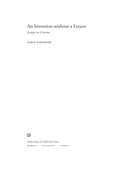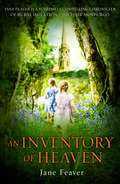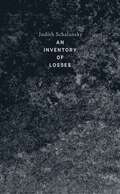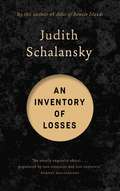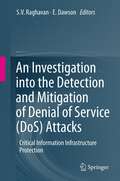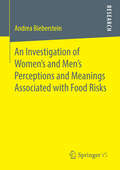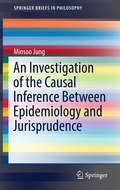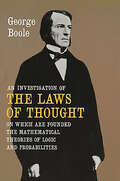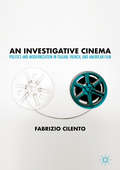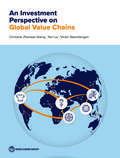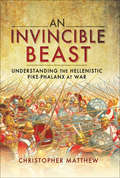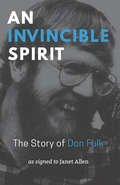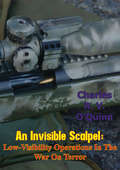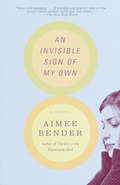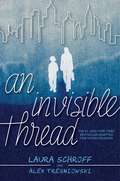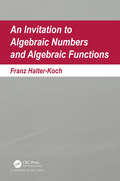- Table View
- List View
An Invention without a Future
by James NaremoreIn 1895, Louis Lumière supposedly said that cinema is "an invention without a future." James Naremore uses this legendary remark as a starting point for a meditation on the so-called death of cinema in the digital age, and as a way of introducing a wide-ranging series of his essays on movies past and present. These essays include discussions of authorship, adaptation, and acting; commentaries on Howard Hawks, Alfred Hitchcock, Orson Welles, Vincente Minnelli, John Huston, and Stanley Kubrick; and reviews of more recent work by non-Hollywood directors Pedro Costa, Abbas Kiarostami, Raúl Ruiz, and Apichatpong Weerasethakul. Important themes recur: the relations between modernity, modernism, and postmodernism; the changing mediascape and death of older technologies; and the need for robust critical writing in an era when print journalism is waning and the humanities are devalued. The book concludes with essays on four major American film critics: James Agee, Manny Farber, Andrew Sarris, and Jonathan Rosenbaum.
An Inventory
by Joan WickershamA Vintage Shorts "Short Story Month" Selection In this witty and moving work of short fiction, "you" recall the romantic interests you had once pined for, crushed on from afar, kissed, and never forgot. Exploring the forces of attraction as well as the tender reaches of the heart, Joan Wickersham chronicles these brief episodes from a young woman's history, from Boy 1 in the block corner of a kindergarten classroom to Boy 23. Originally published by One Story and chosen for The Best American Nonrequired Reading 2015, this selection is a generous meditation on the varieties and endurance of love. An ebook short.
An Inventory of Heaven
by Jane FeaverAs a young woman, Mavis Gaunt leaves post-war London to make a new life for herself in rural Devon, where she spent a few blissful months of her childhood as an evacuee. Living alone in the verdant hamlet of Shipleigh, she believes she's found a heaven on earth - until a violent tragedy brings trouble to paradise, and turns Mavis's idyllic solitude into a tormented, guarded isolation. Decades later, the arrival of a newcomer to the village forces Mavis to make a final reckoning: should she take her horrible secret to the grave? Or, should she summon up her ghosts and, in doing so, lay them to rest? An Inventory of Heaven is a lyrical and intimate meditation on the rural life, falling in love and the long passing of time.
An Inventory of Heaven: 'supremely Compelling. '
by Jane FeaverAs a young woman, Mavis Gaunt leaves post-war London to make a new life for herself in rural Devon, where she spent a few blissful months of her childhood as an evacuee. Living alone in the verdant hamlet of Shipleigh, she believes she's found a heaven on earth - until a violent tragedy brings trouble to paradise, and turns Mavis's idyllic solitude into a tormented, guarded isolation. Decades later, the arrival of a newcomer to the village forces Mavis to make a final reckoning: should she take her horrible secret to the grave? Or, should she summon up her ghosts and, in doing so, lay them to rest? An Inventory of Heaven is a lyrical and intimate meditation on the rural life, falling in love and the long passing of time.
An Inventory of Losses
by Judith SchalanskyA dazzling book about memory and extinction from the author of Atlas of Remote Islands A Publishers Weekly Best Book of the Year A Financial Times Best Book of the Year Each disparate object described in this book—a Caspar David Friedrich painting, a species of tiger, a villa in Rome, a Greek love poem, an island in the Pacific—shares a common fate: it no longer exists, except as the dead end of a paper trail. Recalling the works of W. G. Sebald, Bruce Chatwin, or Rebecca Solnit, An Inventory of Losses is a beautiful evocation of twelve specific treasures that have been lost to the world forever, and, taken as a whole, opens mesmerizing new vistas of how we can think about extinction and loss. With meticulous research and a vivid awareness of why we should care about these losses, Judith Schalansky, the acclaimed author of Atlas of Remote Islands, lets these objects speak for themselves: she ventriloquizes the tone of other sources, burrows into the language of contemporaneous accounts, and deeply interrogates the very notion of memory.
An Inventory of Losses: LONGLISTED FOR THE INTERNATIONAL BOOKER PRIZE 2021
by Judith Schalansky"A fine example of everyone's favourite genre: the genre-defying book, inspired by history, filtered through imagination and finished with a jeweller's eye for detail" JOHN SELF, Guardian"As we deal with the consequences, emotional and material, of a pandemic, it is hard to imagine a better guide to the resources of hope than Schalansky's deeply engaging inventory" MICHAEL CRONIN, Irish Times"Weaving fiction, autobiography and history, this sumptuous collection of texts offers meditations on the diverse phenomena of decomposition and destruction" Financial Times "Books of the Year""Pure gold storytelling" SJONJudith Schalansky's strange and wonderful new book, recalling writers as different as W.G. Sebald and Christa Wolf, Joan Didion and Rebecca Solnit, sees her return to the territory she explored so successfully with her best-selling Atlas of Remote Islands: Fifty Islands I Have Never Set Foot On and Never Will, which Robert MacFarlane called "utterly exquisite" (Guardian) and about which Time Out's reviewer said "Rarely has armchair travel been so farflung and romantic".Judith Schalansky is a wholly original writer whose books articulate perfectly what she wishes to say. Each of the pieces, following the conventions of a different genre, considers something that is irretrievably lost to the world, including the paradisal pacific island of Tuanaki, the Caspian Tiger, the Villa Sacchetti in Rome, Sappho's love poems, Greta Garbo's fading beauty, a painting by Caspar David Friedrich, and the former East Germany's Palace of the Republic. As a child of the former East Germany, it's not surprising that the dominant emotion in Schalansky's work should be "loss" and its aftermath, but what is extraordinary is the thoroughly engaging mixture of intellectual curiosity, down-to-earth grasp of life's pitiless vitality, ironic humour, stylistic elegance and intensity of feeling that combine to make this book a masterpiece and one of the most original and beautifully designed books to be published in 2020.Translated from the German by Jackie Smith
An Investigation Report on Large Public Hospital Reforms in China (Current Chinese Economic Report Series #0)
by Lulu Zhang Meina Li Feng Ye Tao Ding Peng KangThis book provides a comprehensive understanding of public hospital reform in China, which is a hot topic for China's new round of health sector reform. The authors use rich data from both health provider side and service user side and conduct a cross-sectional study in China with some comparative analysis between different locations. It provides the audience with a big picture of China's public hospital and other components of health system as well. The book reviews the main policy measurements in the public hospital reforms and evaluates how these policies influence public hospitals' practices, especially on hospital governance and internal management.
An Investigation into the Detection and Mitigation of Denial of Service (DoS) Attacks: Critical Information Infrastructure Protection
by E Dawson S. V. RaghavanAround the globe, nations face the problem of protecting their Critical Information Infrastructure, normally referred to as Cyber Space. In this monograph, we capture FIVE different aspects of the problem; High speed packet capture, Protection through authentication, Technology Transition, Test Bed Simulation, and Policy and Legal Environment. The monograph is the outcome of over three years of cooperation between India and Australia.
An Investigation of Output Variance Before and During Inflation Targeting
by Francisco Nadal-De SimoneA report from the International Monetary Fund.
An Investigation of Some Macro-Financial Linkages of Securitization
by Andreas Jobst Mangal Goswami Xin LongA report from the International Monetary Fund.
An Investigation of Women's and Men's Perceptions and Meanings Associated with Food Risks
by Andrea BiebersteinConcern about food risks is widespread. Consumers, however, are found to differ in terms of how they evaluate these risks. One of the most prominent findings in this regard is the differences between women and men. Many studies report that men are less worried about environmental and technological risks than women, which is also the case for food risks. At the same time it is criticized that these differences are often exaggerated, similarities overlooked, and systematic investigations are lacking. Andrea Bieberstein gives a comprehensive overview of theoretical approaches to risk perception and empirical work that has been conducted in the field of risk perception research. Furthermore, she provides a systematic investigation of how food risks are constructed for women and men by uncovering the meanings in terms of associations, feelings, and values that they attach to various food risks. This allows a deeper understanding of the gender differences in risk perception in terms of their relevance and meaning.
An Investigation of the Causal Inference between Epidemiology and Jurisprudence (SpringerBriefs in Philosophy)
by Minsoo JungThis book examines how legal causation inference and epidemiological causal inference can be harmonized within the realm of jurisprudence, exploring why legal causation and epidemiological causation differ from each other and defining related problems. The book also discusses how legal justice can be realized and how victims' rights can be protected. It looks at epidemiological evidence pertaining to causal relationships in cases such as smoking and the development of lung cancer, and enables readers to correctly interpret and rationally use the results of epidemiological studies in lawsuits. The book argues that in today's risk society, it is no longer possible to thwart the competence of evidence using epidemiological research results. In particular, it points out that the number of cases that struggle to prove a causal relationship excluding those using epidemiological data will lead to an increase in the number of lawsuits for damages that arise as a result of harmful materials that affect our health. The book argues that the responsibility to compensate for damages that have actually occurred must be imputed to a particular party and that this can be achieved by understanding causal inferences between jurisprudence and epidemiology. This book serves as a foundation for students, academics and researchers who have an interest in epidemiology and the law, and those who are keen to discover how jurisprudence can bring these two areas together.
An Investigation of the Laws of Thought
by George BooleGeorge Boole was on of the greatest mathematicians of the 19th century, and one of the most influential thinkers of all time. Not only did he make important contributions to differential equations and calculus of finite differences, he also was the discoverer of invariants, and the founder of modern symbolic logic. According to Bertrand Russell, "Pure mathematics was discovered by George Boole in his work published in 1854."This work is the first extensive statement of the modern view that mathematics is a pure deductive science that can be applied to various situations. Boole first showed how classical logic could be treated with algebraic terminology and operations, and then proceeded to a general symbolic method of logical interference; he also attempted to devise a calculus of probabilities which could be applied to situations hitherto considered beyond investigation.The enormous range of this work can be seen from chapter headings: Nature and Design of This Work; Signs and Their Laws; Derivation of Laws; Division of Propositions; Principles of Symbolical Reasoning; Interpretation; Elimination; Reduction; Methods of Abbreviation; Conditions of a Perfect Method; Secondary Propositions; Methods in Secondary Propositions; Clarke and Spinoza; Analysis, Aristotelian Logic; Theory of Probabilities; General Method in Probabilities; Elementary Illustrations; Statistical Conditions; Problems on Causes; Probability of Judgments; Constitution of the Intellect. This last chapter, Constitution of the Intellect, is a very significant analysis of the psychology of discovery and scientific method.
An Investigative Cinema: Politics and Modernization in Italian, French, and American Film
by Fabrizio CilentoThis book traces the development of investigative cinema, whose main characteristic lies in reconstructing actual events, political crises, and conspiracies. These documentary-like films refrain from a simplistic reconstruction of historical events and are mainly concerned with what does not immediately appear on the surface of events. Consequently, they raise questions about the nature of the “truth” promoted by institutions, newspapers, and media reports. By highlighting unanswered questions, they leave us with a lack of clarity, and the questioning of documentation becomes the actual narrative. Investigative cinema is examined in relation to the historical conjunctures of the “economic miracle” in Italy, the simultaneous decolonization and reordering of culture in France, the waves of globalization and neoliberalism in post-dictatorial Latin America, and the post-Watergate, post-9/11 climate in US society. Investigative cinema is exemplified by the films Salvatore Giuliano, The Battle of Algiers, The Parallax View, Gomorrah, Zero Dark Thirty, and Citizenfour.
An Investment Perspective on Global Value Chains
by Yan Liu Christine Zhenwei Qiang Victor SteenbergenThis report investigates the role of foreign direct investment (FDI) in helping developing countries participate in global value chains (GVCs). It combines the perspectives and strategies from three types of players: multinational corporations, domestic firms and governments. It aims to provide practical guidance for developing countries to develop strategies that use FDI to strengthen GVC participation and upgrading. The report has six main chapters: 1. FDI and GVCs. Assesses the trade-investment nexus and analyzes the effect of FDI in countries’ GVC participation and upgrading at the country level. 2. MNCs shape GVC development. Highlights MNCs' contribution to global economy and how their business strategies shape the evolution of GVCs. The chapter also compares MNCs' business strategies in terms of outsourcing and offshoring, risk mitigation and increasing market power across GVC archetypes. 3. Domestic firm perspectives on GVC participation. Looks at the various paths domestic firms can take to internationalize their production and trade. Investigates domestic firm characteristics that predict higher GVC participation, and the effect of GVC participation on firm performance. 4. Investment policy and promotion: what is in a government’s toolbox? Summarizes the various policy instruments governments have at their disposal to help attract MNCs to their country and facilitate GVC participation of domestic firms. 5. Integrating countries into GVCs. Draws on a range of case studies to illustrate how governments can develop coherent strategies and policy packages to integrate their countries into GVCs. 6. FDI and GVCs in the wake of COVID-19. Reflects the impact of COVID-19 on FDI and GVCs, the response from multinationals and suppliers, and the implications for GVC reconfiguration. In addition, there are seven case studies that offer more nuanced analysis on the GVC participation in selected countries and sectors: • Five qualitative case studies: Five countries have been selected that managed to use FDI to stimulate GVC participation using a range of approaches. By design, these five countries also cover five different GVC archetypes. These countries are: (1) Kenya (horticulture); (2) Dominican Republic (textiles); (3) Mauritius (tourism); (4) Malaysia (electronics); (5) China (software). • Two quantitative case studies: Rwanda, West-Bengal (India). These use a combination of firm- and transaction level datasets to study firm-level dynamics that explain the role of multinational and domestic firms across GVCs.
An Invincible Beast: Understanding the Hellenistic Pike Phalanx in Action
by Christopher MatthewThe Hellenistic pike-phalanx was a true military innovation, transforming the face of warfare in the ancient world. For nearly 200 years, from the rise of the Macedonians as a military power in the mid-fourth century BC, to their defeat at the hands of the Romans at Pydna in 168BC, the pike-wielding heavy infantryman (the phalangite) formed the basis of nearly every Hellenistic army to deploy on battlefields stretching from Italy to India. And yet, despite this dominance, and the vast literature dedicated to detailing the history of the Hellenistic world, there remains fierce debate among modern scholars about how infantry combat in this age was actually conducted.Christopher Matthews critically examines phalanx combat by using techniques such as physical re-creation, experimental archaeology, and ballistics testing, and then comparing the findings of this testing to the ancient literary, artistic and archaeological evidence, as well as modern theories. The result is the most comprehensive and up-to-date study of what heavy infantry combat was like in the age of Alexander the Great and his successors.
An Invincible Spirit: The Story of Don Fulk
by Janet Allen“Don taught us how to be a real independent living center. Nothing was easy; every issue that came up on the road to Don’s independence was a challenge and a struggle, but the experience pushed us and we learned from it. We were not going to let Don down; all of us were committed to Don’s freedom and independence.” —Kathleen Kleinman, Executive Director, TRPIL (Transitional Paths to Independent Living) Profoundly deafened as an infant, Don Fulk didn’t learn his name or go to school until the age of ten. When he was eighteen years old and a budding superstar on his football and basketball teams, he broke his neck in a swimming accident, and became paralyzed. After his injury, he was confined to a bed in his parents’ home for eight years, unable to move and barely able to communicate. After his family could no longer care for him, he spent nine years in a nursing home where he suffered from abuse and neglect. Yet through a life marred by isolation and frustration, Fulk endured with strength, humor, and grace. He never gave up pursuing his dreams for independence and self-worth, and improving the lives of others. He fought a system that was unfair and discriminatory, and helped pave the way for people with disabilities to live independently. Don Fulk signed his story to author Janet Allen, describing his difficult home life, the incredible friends who changed his life, and his dramatic escape from an abusive nursing home. An Invincible Spirit is a story of hope, empowerment, and the battles people with disabilities have fought—and continue to fight—to improve the quality of their lives.
An Invincible Spirit: The Story of Don Fulk
by Janet Allen“Don taught us how to be a real independent living center. Nothing was easy; every issue that came up on the road to Don’s independence was a challenge and a struggle, but the experience pushed us and we learned from it. We were not going to let Don down; all of us were committed to Don’s freedom and independence.” —Kathleen Kleinman, Executive Director, TRPIL (Transitional Paths to Independent Living) Profoundly deafened as an infant, Don Fulk didn’t learn his name or go to school until the age of ten. When he was eighteen years old and a budding superstar on his football and basketball teams, he broke his neck in a swimming accident, and became paralyzed. After his injury, he was confined to a bed in his parents’ home for eight years, unable to move and barely able to communicate. After his family could no longer care for him, he spent nine years in a nursing home where he suffered from abuse and neglect. Yet through a life marred by isolation and frustration, Fulk endured with strength, humor, and grace. He never gave up pursuing his dreams for independence and self-worth, and improving the lives of others. He fought a system that was unfair and discriminatory, and helped pave the way for people with disabilities to live independently. Don Fulk signed his story to author Janet Allen, describing his difficult home life, the incredible friends who changed his life, and his dramatic escape from an abusive nursing home. An Invincible Spirit is a story of hope, empowerment, and the battles people with disabilities have fought—and continue to fight—to improve the quality of their lives.
An Invisible Force: The Quest to Define the Laws of Motion (Panorama)
by Glen PhelanNIMAC-sourced textbook
An Invisible Scalpel: Low-Visibility Operations in the War on Terror
by Charles R. V. O’QuinnThe War on Terror (WOT) is actually a war against extremist insurgents comprised of numerous and varied organizations scattered across the globe. They are spurred to action by an extremist ideology that is nurtured, demonstrated, and led by al Qaeda and its leadership. This ideology serves as the insurgency's center of gravity whereby it gains all manner of support across a broad spectrum of functional resources in multiple operational domains. As operating environments change, these ideology inspired decentralized insurgent organizations are able to quickly adapt their methods of operation. In order to defeat this evolving, ubiquitous yet elusive threat, the US must develop a comprehensive strategy that incorporates all instruments of US national power, as well as those of its allies. This strategy must also defeat or mitigate the enemy's center of gravity in order to have any chance of success. This thesis argues that as lead combatant command in the WOT, the US Special Operations Command (USSOCOM) should conduct continuous, global, pre-emptive low-visibility operations in order to disrupt insurgent operations. In order to accomplish its WOT missions, USSOCOM must effectively organize and array forces and resources to defeat insurgent functional resources across multiple operational domains.
An Invisible Sign of My Own: A Novel
by Aimee BenderAimee Bender's stunning debut collection, The Girl in the Flammable Skirt, proved her to be one of the freshest voices in American fiction. Now, in her first novel, she builds on that early promise.Mona Gray was ten when her father contracted a mysterious illness and she became a quitter, abandoning each of her talents just as pleasure became intense. The only thing she can't stop doing is math: She knocks on wood, adds her steps, and multiplies people in the park against one another. When Mona begins teaching math to second-graders, she finds a ready audience. But the difficult and wonderful facts of life keep intruding. She finds herself drawn to the new science teacher, who has an unnerving way of seeing through her intricately built façade. Bender brilliantly directs her characters, giving them unexpected emotional depth and setting them in a calamitous world, both fancifully surreal and startlingly familiar.From the Trade Paperback edition.
An Invisible Thread: A Young Readers' Edition
by Alex Tresniowski Laura SchroffFrom New York Times bestselling authors Laura Schroff and Alex Tresniowski comes the young readers edition of an unbelievable memoir about an unlikely friendship that forever changed the lives of a busy sales executive and a hungry eleven-year-old boy.On one rainy afternoon, on a crowded New York City street corner, eleven-year-old Maurice met Laura. Maurice asked Laura for spare change because he was hungry, and something made Laura stop and ask Maurice if she could take him to lunch. Maurice and Laura went to lunch together, and also bought ice cream cones and played video games. It was the beginning of an unlikely and magical friendship that changed both of their lives forever. An Invisible Thread is the true story of the bond between an eleven-year-old boy and a busy sales executive; a heartwarming journey of hope, kindness, adventure, and love—and the power of fate to help us find our way.
An Invisible Thread: The True Story of an 11-Year-Old Panhandler, a Busy Sales Executive, and an Unlikely Meeting with Destiny (Current Practices in Ophthalmology)
by Valerie Salembier Alex Tresniowski Laura SchroffAn Invisible Thread tells of the life-long friendship between a busy sales executive and a disadvantaged young boy, and how both of their lives were changed by what began as one small gesture of kindness.When Laura Schroff brushed by a young panhandler on a New York City corner one rainy afternoon, something made her stop and turn back. She took the boy to lunch at the McDonald's across the street that day. And she continued to go back, again and again for the next four years until both their lives had changed dramatically. Nearly thirty years later, that young boy, Maurice, is married and has his own family. Now he works to change the lives of disadvantaged kids, just like the boy he used to be. An Invisible Thread is the true story of the bond between a harried sales executive and an eleven-year-old boy who seemed destined for a life of poverty. It is the heartwarming story of a friendship that has spanned three decades and brought meaning to an over-scheduled professional and hope to a hungry and desperate boy living on the streets.
An Invitation To Algebraic Numbers And Algebraic Functions
by Franz Halter-KochThe author offers a thorough presentation of the classical theory of algebraic numbers and algebraic functions which both in its conception and in many details differs from the current literature on the subject. The basic features are: Field-theoretic preliminaries and a detailed presentation of Dedekind’s ideal theory including non-principal orders and various types of class groups; the classical theory of algebraic number fields with a focus on quadratic, cubic and cyclotomic fields; basics of the analytic theory including the prime ideal theorem, density results and the determination of the arithmetic by the class group; a thorough presentation of valuation theory including the theory of difference, discriminants, and higher ramification. The theory of function fields is based on the ideal and valuation theory developed before; it presents the Riemann-Roch theorem on the basis of Weil differentials and highlights in detail the connection with classical differentials. The theory of congruence zeta functions and a proof of the Hasse-Weil theorem represent the culminating point of the volume. The volume is accessible with a basic knowledge in algebra and elementary number theory. It empowers the reader to follow the advanced number-theoretic literature, and is a solid basis for the study of the forthcoming volume on the foundations and main results of class field theory. Key features: • A thorough presentation of the theory of Algebraic Numbers and Algebraic Functions on an ideal and valuation-theoretic basis.• Several of the topics both in the number field and in the function field case were not presented before in this context.• Despite presenting many advanced topics, the text is easily readable. Franz Halter-Koch is professor emeritus at the university of Graz. He is the author of “Ideal Systems” (Marcel Dekker,1998), “Quadratic Irrationals” (CRC, 2013), and a co-author of “Non-Unique Factorizations” (CRC 2006).
An Invitation To Health (Tenth Brief Edition): The Power of Now
by Dianne HalesExplore AN INVITATION TO HEALTH, The Power of Now, Brief, 10th Edition, where renowned author Dianne Hales helps you commit to a healthier lifestyle. From physical and mental health to social and sexual issues, this personal health text candidly explores the mind, body, and spirit, and shows you how to start making better health choices today.
